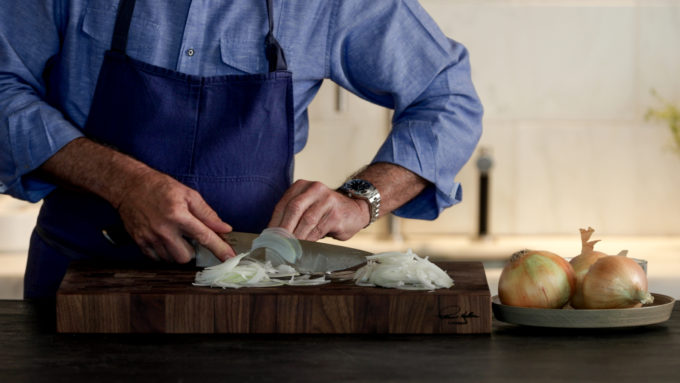Thomas Keller Answers the Most-Asked Knife Skills Questions

We looked at some of the most-Googled questions about knives and knife skills and then decided to answer all those queries by turning to THE pro: Chef Thomas Keller. Not only does the renowned, award-winning chef (obviously) use knives every dayat The French Laundry and any of his other restaurants in the Thomas Keller Restaurant Grouphe also just spent a lot of time thinking about cutlery: He recently worked in collaboration with Cangshan to launch his very own line of knivesThe Thomas Keller Signature Collection.
The chef and the Cangshan knife makers spent nearly two years designing every detail, from the shape of the handle to the slant of the bolster. The resulting knives are made from the best Swedish Damasteel and have an unparalleled strength, sharpness, and balance. They’re also exclusive to Williams Sonoma.
So while the chef was in the office to debut his knives, we decided to put him on the spot and ask him those hard knife-related questions. He had some good, um, points.
How can I improve my knife skills?
When it comes to getting better with chopping, slicing, or dicing, Keller has bad news for you: There are no shortcuts. How do you get to Carnegie Hall? he asks. Practice, practice, practice. Stop into our stores to see when you can sign up for a knife skill class. Or check out this post, in which Keller walks us through the some key exercises.
What are the basic knife cuts?
There’s slicing, dicing chopping, all of which you’ve already heard of. And then there’s macdoine (“which is a cube”), allumette (“which looks like a matchstick”) and you have batonnet. “All French techniques!” he says.
And what’s the difference between chopping and dicing?
Good question! They sound like they’d be the same thing, but they actually aren’t. “Chopping is not uniform, whereas with dicing, you want to have nice, uniform pieces.” For example, you can chop up a handful of parsley, but you’d dice up a tomato.
What exactly are knife skills?
“Knife skills are you, practicing the different elements of using a knife,” he says. “Whether that’s holding a knife, sharpening a knife, honing a knife, using a knife to slice, to dice, to chop … those kinds of things.” These are all key things for you to be able to do with your knife so it’s important to practice “and HONE your knife skills,” Keller adds.

How do you not cry when cutting onions.
“Chop them really, really fast,” he says, only half jokingly. That’s easy for an award-winning chef to say, though! If your knife skills are only a fraction as good as Chef Keller’s, allow us to suggest a few other tips. You can try chilling the onions in the freezer for 10 to 15 minutes before you chop them. Or put a piece of bread in your mouth and let it hang out there while you chop. Both of these methods work shockingly well.
What should you NOT do with a knife?
“You should never ever, ever drop a knife.” If you do happen to drop one, try to get your feet out of the way as quickly as possible. Safety first, you guys!

